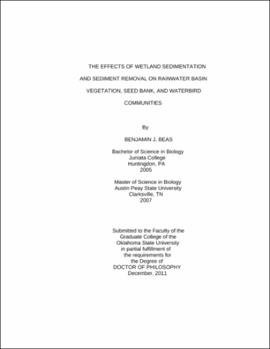| dc.contributor.advisor | Smith, Loren Michael | |
| dc.contributor.author | Beas, Benjamin James | |
| dc.date.accessioned | 2013-11-26T08:28:21Z | |
| dc.date.available | 2013-11-26T08:28:21Z | |
| dc.date.issued | 2011-12 | |
| dc.identifier.uri | https://hdl.handle.net/11244/7026 | |
| dc.description.abstract | Scope and Method of Study: The purpose of this study was to assess the effects of restoration, by sediment removal, on wetlands located in the Rainwater Basin region of NE. Assessment included 3 objectives: extant vegetation (2008 & 2009), seed banks (2009), and using models to predict waterbird use (2008 & 2009) among reference, restored, and cropland wetlands. | |
| dc.description.abstract | Findings and Conclusions: Objective 1:For both years of the study, restored wetlands had more similar plant community characteristics (e.g., species richness) to reference wetlands than to cropland wetlands. Even though restored wetlands had similar plant community characteristics to reference wetlands, CCA results depicted that reference and restored wetlands are associated with differing plant species and guilds. In addition, restored wetland plant communities do not appear to be acting as intermediates between reference and cropland conditions or be on a trajectory to reach reference condition. Objective 2:There was no difference in the germinating seed bank plant community of reference, restored, and cropland wetlands. Cropland wetlands contained the greatest proportion of exotic species compared to reference and restored wetlands. Availability of seeds after removing 30 cm of sediment was low indicating that the seed bank was not the primary mechanism for plant recolonization of restored wetlands. Sediment removal was successful in removing weedy and invasive species from the seed bank. Objective 3:During wet years, restored wetlands were predicted, although not statistically significant, to have nearly twice the abundance of dabbling and diving ducks as reference and cropland wetlands and twice as many geese and contain 5 more species of waterbirds compared to reference wetlands. In dry years, restored wetlands were predicted, although not statistically significant, to have the greatest abundance of dabbling ducks, diving ducks, shorebirds, and geese among the 3 wetland types. In years of low precipitation, reference and restored wetlands are the primary habitat available for waterbirds during migration because most cropland wetlands are dry. Models predicted that restored wetlands within the Rainwater Basin will provide improved habitat needed for migrating waterbirds during spring migration. | |
| dc.format | application/pdf | |
| dc.language | en_US | |
| dc.rights | Copyright is held by the author who has granted the Oklahoma State University Library the non-exclusive right to share this material in its institutional repository. Contact Digital Library Services at lib-dls@okstate.edu or 405-744-9161 for the permission policy on the use, reproduction or distribution of this material. | |
| dc.title | Effects of wetland sedimentation and sediment removal on rainwater basin vegetation, seed bank, and water bird communities | |
| dc.contributor.committeeMember | McMurry, Scott T. | |
| dc.contributor.committeeMember | Davis, Craig A. | |
| dc.contributor.committeeMember | Hickman, Karen R. | |
| osu.filename | Beas_okstate_0664D_11834 | |
| osu.accesstype | Open Access | |
| dc.type.genre | Dissertation | |
| dc.type.material | Text | |
| dc.subject.keywords | conservation | |
| dc.subject.keywords | depressional wetland | |
| dc.subject.keywords | efficient-community hypothesis | |
| dc.subject.keywords | nebraska | |
| dc.subject.keywords | plant species composition | |
| dc.subject.keywords | restorat | |
| thesis.degree.discipline | Zoology | |
| thesis.degree.grantor | Oklahoma State University | |
